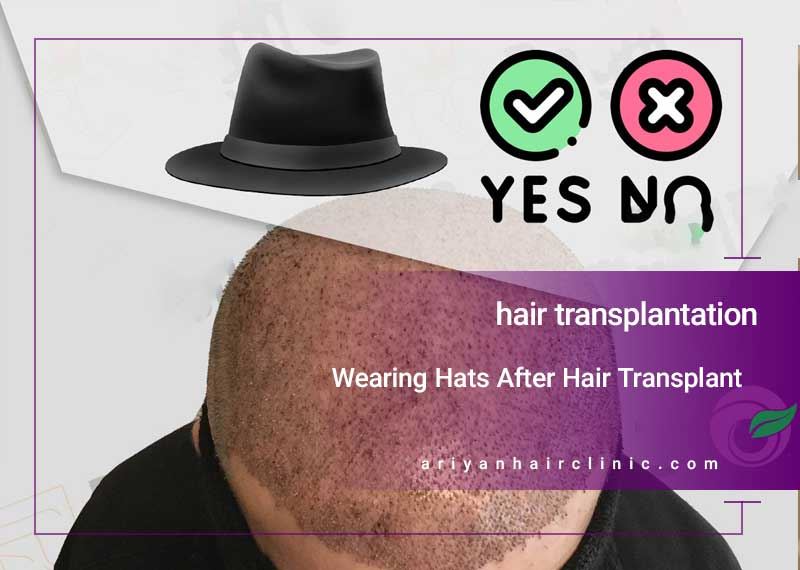Does Wearing a Hat After Hair Transplant Cause Harm?
1404/03/19

If you are worried about wearing a hat after a hair transplant, reading this article will help you understand whether your concern is justified or not.
If you are concerned about wearing a hat after a hair transplant, reading this article will help you determine whether your concern is valid.
Is Wearing a Hat Recommended After a Hair Transplant?
If you work or spend a lot of time outdoors and are worried about your newly transplanted hair, you may have already considered wearing different types of hats to cover your scalp.
Swelling, scabbing, and bruising after a hair transplant can be uncomfortable and unsightly. Additionally, newly transplanted hair follicles require several months for the wounds to heal and for normal hair growth to resume.
In many cases, doctors recommend wearing a hat after a hair transplant to hide the wounds and protect the scalp from sunlight, dust, and harsh weather conditions.
Therefore, if proper hygiene is maintained, wearing a hat after a hair transplant is generally safe.
When Can You Start Wearing a Hat After a Hair Transplant?
Wearing a hat immediately after surgery can compress, dislodge, or damage the grafts — a risk that no patient wants after investing in a hair transplant.
Such damage may cause patchy bald spots and negatively impact the overall success of the procedure.
You should wait at least 7 to 10 days after the surgery before wearing a hat. This allows time for the grafts to stabilize and the wounds to partially heal before any pressure is applied.
Characteristics of an Ideal Hat After Hair Transplantation
Choosing the right hat is crucial to avoid harming the newly transplanted follicles:
-
Use hats specifically designed for hair transplant recovery after the first 7 to 10 days.
-
Hats should be lightweight and should not create static electricity or friction with the scalp.
-
Avoid tight, restrictive hats that could put pressure on the grafts.
-
If a specialized hair transplant hat is unavailable, avoid cotton hats that may stick to the scalp.
How to Wear a Hat Without Damaging New Hair
To protect newly transplanted follicles:
-
Make sure the hat is loose-fitting and does not touch the grafts.
-
Always use both hands to gently place and remove the hat.
-
Do not press or rub the hat against the scalp.
-
Limit hat-wearing time to 5 to 6 hours per day to minimize pressure on the grafts.
Reasons and Timing for Wearing a Hat After Hair Transplantation
Wearing a hat after surgery is not just about aesthetics. It offers real protection:
-
Dust and Pollution: Wind carries fine dust particles that can cause infections if they contact the open wounds on the scalp.
-
Sun Exposure: Direct sunlight can worsen inflammation, cause sunburns, and severely damage newly transplanted follicles.
-
Wind and Rain: Although mild wind and rain don't directly harm the grafts, in the early days post-surgery, they can irritate the sensitive scalp or dislodge unstable grafts.
Thus, it is crucial to use a hat, especially outdoors, for at least the first 10 days after surgery.
Timeline for Using a Hat After Hair Transplantation
Healing from a hair transplant takes several weeks.
-
After one week, you can begin wearing a loose hat outdoors.
-
After two weeks, the scalp continues healing, but you should still protect it during outdoor activities.
-
Full scalp recovery and the ability to stop using a hat outdoors usually occur after two months.
In polluted cities like Tehran, or during windy and sunny conditions, wearing a hat remains especially important.
Additional Hair Care Tips After a Hair Transplant
Proper care ensures you achieve beautiful, thick hair after a transplant:
-
Avoid using cotton or heavy helmets (like motorcycle helmets) early after surgery.
-
Keep your hat clean; wash and disinfect it regularly to prevent infection.
-
Never let dirt, blood, or fluids accumulate inside the hat.
-
Protect the scalp from dust, sunlight, and bad weather consistently during the healing phase.
How to Wash Your Eyebrows and Scalp After Hair Transplant
-
First 1–2 days: Avoid washing the area.
-
After 2 days: Use lukewarm water and gently wash in the direction of hair growth.
-
After a week: You may use a mild shampoo recommended by your doctor, always rinsing with warm (not hot) water.
Proper hygiene helps prevent infection and supports the survival of new grafts.
Impact of Hair Loss on Mental Health
Hair loss can have significant emotional effects, especially in women.
Studies show that even years after losing hair, individuals often desire to restore their former appearance.
Eyebrow and hair transplantation offers a permanent, confidence-boosting solution.
Frequently Asked Questions (FAQs) About Hat Use After Hair Transplant
When can I start reshaping my eyebrows after transplantation?
You can begin reshaping and using cosmetic products on your eyebrows about four weeks after the procedure.
What should I do after an eyebrow transplant?
At Arian Clinic, our consultants will provide detailed, personalized post-operative instructions to ensure your success.
How can eyebrow transplantation change my appearance?
-
Aesthetic enhancement: Gives you a more defined, attractive facial look.
-
Better facial expression: Eyebrows play a crucial role in human expression.
-
Protection: Eyebrows shield the eyes from dust, sweat, and sunlight.
How much does eyebrow transplantation cost?
The cost depends on the size of the transplant area and the cause of eyebrow loss.
Contact us directly for accurate pricing and consultation.
Contact a Fully Equipped Hair Transplant Clinic in Shiraz
For more information about eyebrow and hair transplantation services, talented surgeons, healthcare professionals, and world-class facilities at Arian Hair Clinic, contact us today!
We are committed to excellence, patient care, and outstanding surgical results.
Let us answer your questions and show you how our expert team can make a real difference.
Thanks to Arian Clinic’s specialists, your hair can once again become your greatest asset.
Contact us today to schedule a consultation!


User-Comments